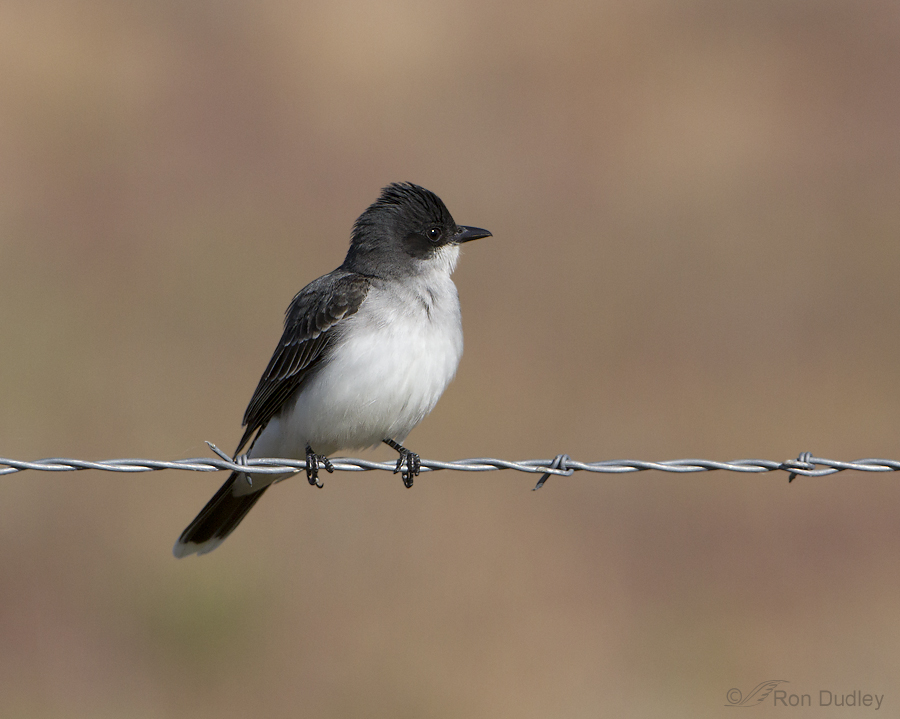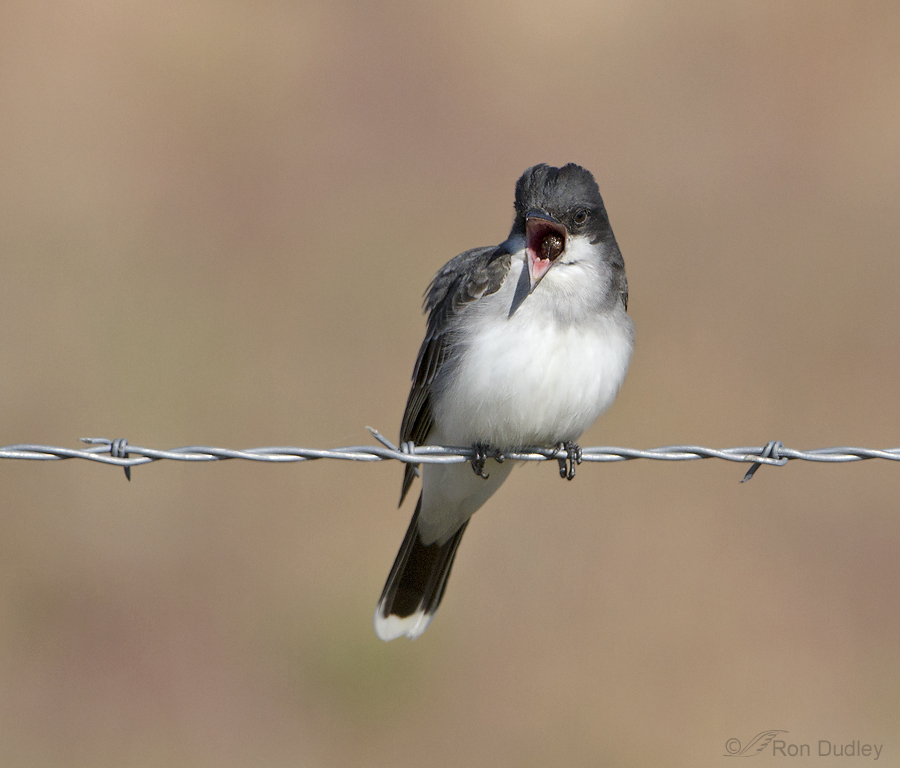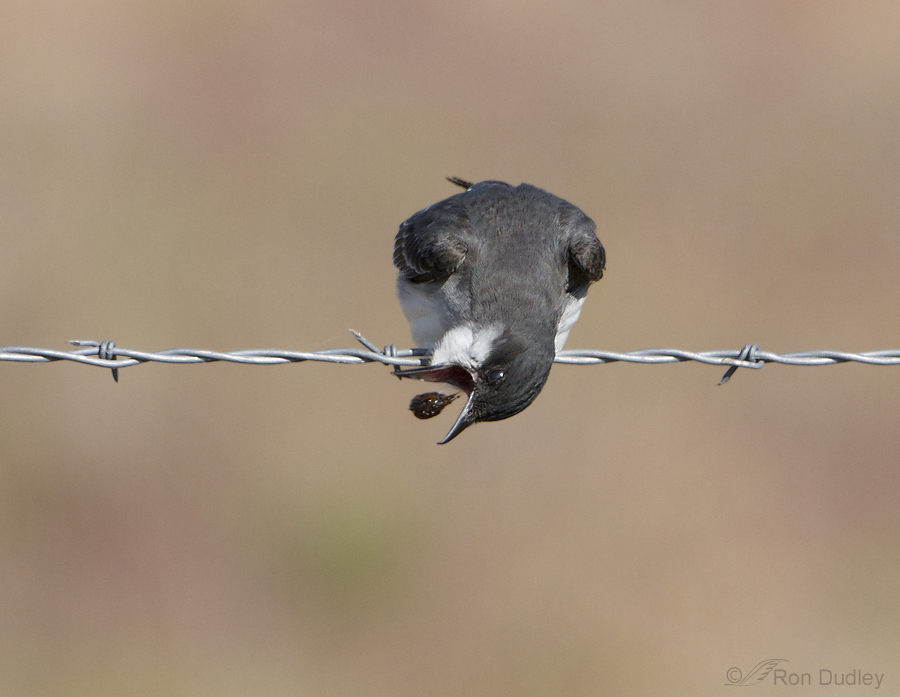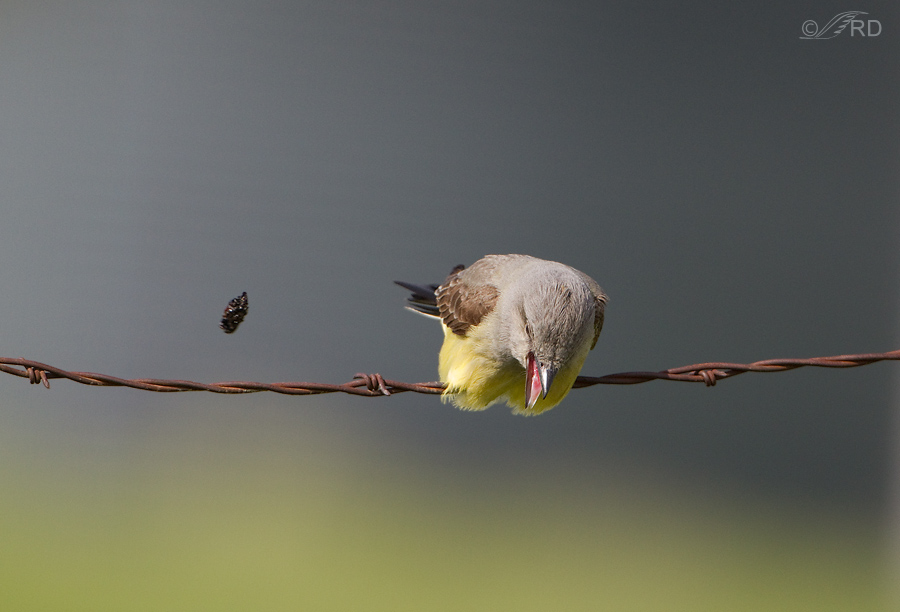Yesterday morning at Bear River Migratory Bird Refuge I saw kingbirds galore – mostly Western but also a few Eastern Kingbirds. Both species are known for their penchant for perching on fences as they hunt for their insect prey.
But when they paved the 10 mile dirt/gravel access road to the refuge last year (something I’m not happy about for a variety of reasons, but that’s another story…) they also removed many of the old rustic fences with their weathered wooden posts and rusty wire and replaced them with new metal posts and shiny new wire – far from rustic and appealing. So when I happened upon this Eastern Kingbird on shiny new wire I wasn’t very enthusiastic about photographing it and I didn’t even work very hard at getting an interesting pose.
In fact I was so uninterested in the photographic prospects of the bird on the shiny wire that I took off my tc, increased my shutter speed to 1/3200 sec and waited for a take-off shot (which I never did get successfully).
But suddenly it became obvious that the kingbird was about to cast a pellet. These birds eat insects but cannot digest their chitinous exoskeletons so they regurgitate them as compacted pellets. The action is fast and it’s usually difficult to get a good look at the pellet, in the mouth or as it is flung away. But here you can see the pellet back in the throat as the kingbird tries to bring it up far enough so it can be expelled.
At this point they have a very difficult time getting it out of their throat so they vigorously shake their heads and use centrifugal force to fling it out.
The position of the head as the pellet flies out is happenstance of course. I just happened to luck out and catch the pellet clear from the beak but still enclosed within the open mandibles (I also got a catch light, something I didn’t get in most of my other shots of this bird because it was late in the morning and the sun was high). Even though this was a fairly large crop without my tc attached I was still happy to get the shot – yes, I am a behavior freak…
Early last spring I was able photograph this Western Kingbird casting a pellet with the same violent head shaking used by the Eastern Kingbird. This time the pellet was flung far to the side. (I’ve posted this shot once before).
Birds of North America Online (BNA) is my “bird bible” and when I researched their site last year they listed “no information” for pellet casting in this species, even though they did mention pellet casting as a documented behavior in Eastern Kingbirds. So when I got this shot I sent BNA a link to the photo since I figured they might be interested in a species behavior they apparently weren’t aware of. It turned out that they were and they asked for permission to use my photo, which I granted. I suspect that the photo may be used to document this behavior in Western Kingbirds when they next update their profile of the species.
I’ve long been interested in pellet formation and casting in birds – which species do it, which ones don’t, and why. Researchers study pellets to learn about diet and nutrition in birds and don’t have to kill and dissect them to do so.
And that’s a good thing…
Ron






Thanks, learned something new.
I had no idea! Thanks for the info and the amazing pics. It makes sense that they would do this, and it is great that you had a chance to photograph this behavior and share it.
Never seen this until one of your posts, had vaguely heard of owl pellets but had no clue what they were talking about. Thanks for the education. Bet that was a surprise!
Ron, this is fantastic! I never knew! Thanks so much for sharing!
Charlotte Norton
Incredible. How lucky that you were there to see it. And how lucky WE were that you were there to see, to capture and to share. Thank you.
And I love that you will be educating people who may never find you here about bird behaviour. Educating and illustrating in your own matchless style. BNA knew when they were onto a good thing.
This education stuff is addicting, isn’t it, Elephant’s Child? A big part of why I continue to blog is because the info flows both ways. I think I learn just as much from those who comment here as others may learn from me on occasion. And I love that ebb and flow.
Now that is something that I have not only never seen in the real world I have never even seen a photo of it happen before.
Great timing and thank you for sharing Ron.
Barry
Thanks, Barry. I truly enjoy presenting new and interesting “stuff” to my readers.
Super post, Ron! And timely. I’ve got my eye on an Eastern Kingbird pair for which I’m trying to locate a nest. They’ve both been hunting regularly but I haven’t observed any pellet casting yet. I’ll be watching for it in other species, too. Thank you again so much for the education and stunning photography!
Wally, Like I said to Diana, below – watch for pellet casting early in the morning. I think it’ll improve your chances tremendously. Good luck with the kingbird pair!
Ron
I volunteer with raptors and although I collect pellets from owls, turkey vultures and hawks I have never seen them actually cast a pellet.
The carnivorous birds in my backyard must do it out of my eyesight as well.
Thanks for your ability to see and capture.
Diana, In my experience, pellets are usually hacked up in the morning after sufficient time for digestion. Virtually all of my photography is done in the early morning so maybe that’s part of the reason I’ve seen this so often.
Wow, Ron! These are amazing shots. Thank you so much for posting them.
And thank you for appreciating them, Susan.
I remember having a great blue heron in rehab years ago – the morning after intake I found bright red crawdad shells in the hospital cage … we always like to collect the first pellets of birds that come into our care, as it’s interesting to check out what they’ve been eating. Screech owls and kestrels often cast the same kind of chitinous pellets as this kingbird – wads of beetle wings and exoskeletons. Fascinating. Thanks, Ron – that photo of the pellet at the back of the mouth is truly amazing.
Louise, Interesting how the pellet varies according to diet (obviously). Kestrels around here (for much of the year) eat mostly voles and their pellets are largely fur. That said, today I watched a female kestrel (too far away for good photos) apparently try to hack up a pellet. She tried and tried, but eventually all that came out looked mostly like thick mucus.
Nice shot Ron. I share your interest of “Birds at work.”
“Birds at work” are fascinating, John. As they are at play, and many of them play.
WOW Ron! Incredible!
Thanks, Nancy.
I’ve had chimney swifts and purple martins (in for rehabilitation) cast up crunchy little pellets full of the hard shells and wings of bugs. Have always wondered what other songbird species regularly do that. Wonderful pictures of it actually happening, Ron.
Shirley, many insectivorous songbirds hack up pellets. It’s so quickly done that it’s not often noticed unless you’re looking for the tell-tale behavior that immediately precedes it. I’ve seen and photographed it in Loggerhead Shrikes often. Some shorebirds too – Willets, for example.
What delight you share, once again, Ron. Thank you so very much! My educational American Crow sometimes casts pellets, depending upon his diet. He really enjoys eating segments of oranges, which produce tidy orange bundles of membranes.
Fascinating about the crow and the orange membranes, Mikal. I had no idea they couldn’t digest them but I suspect those membranes have a large cellulose component which vertebrates have a very difficult time digesting without the aid of specialized microflora in the gut. Cellulose and chitin (what insect exoskeletons are made of) are chemically similar. There’s even lots of variability in the ability of vertebrates of the same species to digest cellulose – humans and corn kernel husks, for example (as evidenced in the toilet by some folks the next day…)
This post is FASCINATING! It’s a tremendous boone that you are so interested in behavior. Thanks for great photos and intriguing information.
I’m glad to hear that you enjoy posts about behaviors, Janet. I’m enthralled by them and post about them often – a seed that was planted 45 years ago in a college Animal Behavior class. Amazing how such a thing can have a huge effect on your life…
FANTASTIC photo! You must have the patience of a saint, the eyes of an eagle, the ability to turn yourself into a stone , and an “in” with both Mother Nature and the Lord to get some of the shots you get. I had no idea Kingbirds did this. To actually see the pellet in this bird’s mouth is amazing. I feel so lucky to have discovered you and your work. I’m learning so much and i love it. It’s like never ending Christmas!
Thanks so much, Patty. In reality, my eyesight is relatively poor, I’m known for a lack of patience in many things and the Lord and I don’t communicate much… But a different side of me comes out when it comes to spending time with birds.
Fantastic, great behavioral images! Much appreciated!
I did NOT know Flycatchers had this behavior, just goes to show that an ancient can learn new things!!
Do you have images of Owls doing similar casting?
Dick, It’s my understanding that most carnivorous species that consume large quantities of indigestible material (fur, bone, insect exoskeletons etc) cast pellets. Offhand I don’t recall ever photographing owls casting pellets. My best shots of a raptor doing so are of this Swainson’s Hawk.
https://featheredphotography.com/blog/2012/08/26/swainsons-hawk-regurgitating-pellets/
Two other posts with raptors expelling pellets – a Red-tailed Hawk and a Northern Harrier:
https://featheredphotography.com/blog/2011/07/30/red-tailed-hawks-of-utahs-west-desert/
https://featheredphotography.com/blog/2011/02/19/northern-harrier-struggling-to-expel-a-pellet/